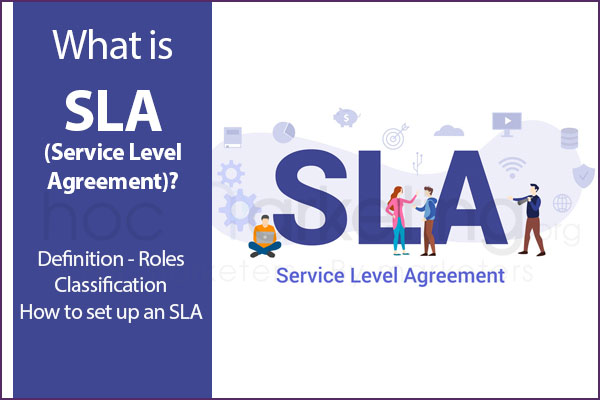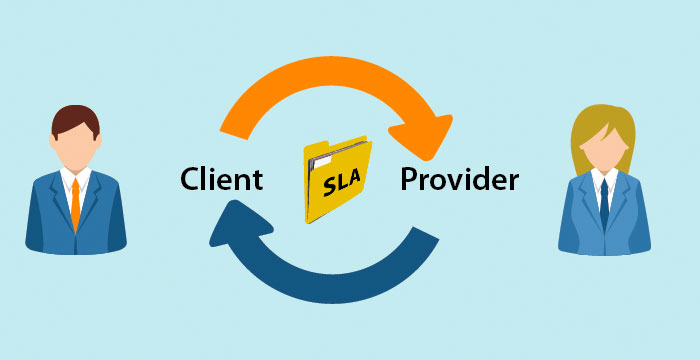
What is SLA (Server Level Agreement)? How to set up an SLA

Service-level agreements (SLA) are an important part of marketing. It is the responsibility of a company to know what services they're offering and how long it will take for them to be delivered. This blog post will give you a general overview of SLA's and what they mean, as well as cover some best practices in setting up a SLA.
Service-level agreements (SLA) are an important part of marketing. It is a form of legal instrument widely used in service providers. It is the responsibility of a company to know what services they're offering and how long it will take for them to be delivered. This blog post will give you a general overview of SLA's and what they mean, as well as cover some best practices in setting up a SLA.
What is an Service-Level Agreement (SLA)?
An SLA is a contract between the business and one of its customers, outlining the level of service that will be offered. It contains agreements between a service provider and a service user in the form of a legal document, in which the service provider is responsible for ensuring the standards related to the service according to the committed content. By signing this contract, it sets up what to expect from the company within their own services or products. This can include timeframes for expected resolutions for errors, deadlines for project delivery and also metrics on how well they are meeting with their customer's expectations.
Short history of Service-Level Agreements (SLAs)
The first SLA was created in 1987 for the US telecom company MCI to specify what level of service they were offering and also guarantee that it would be met. In 1998, Microsoft introduced an online tool called Service Level Manager (SLM). A year later, it became part of Operations Manager and is now known as the Service Level Agreement Wizard.
Nowadays, many large companies use SLAs to ensure they are meeting their customers' expectations. Having a documented process for SLA's is key in making sure that both parties are on the same page with what is expected of them and when.
Major types of SLA
There are 3 major types of SLA: Customer Service-Level Agreement, Internal Service-Level Agreement, Multilevel Service-Level Agreement.
1. Customer Service-Level Agreement
A customer service-level agreement is an agreement between a business and its customers that clearly states what they can expect from the company. This could include how long it will take for someone to respond to their support ticket, or how good of a resolution time they should expect.
For example, a digital marketing company might have an SLA with their customer that says they will respond to support tickets within 1 day and resolutions for the issues should be completed within 2 days.
2. Internal Service-Level Agreement
An internal SLA is one a company creates with its employees. This outlines the service expectation between departments, teams or even individuals within their own organization. They could be related to things such as daily goals, project deadlines and which department has priority when it comes to issues or problems.
For example, the IT department at ABC company has an internal SLA that states they always have priority when it comes to any issues or problems. Another example would be if the finance department had a project due in 2 weeks time, but was delayed because of other departments not meeting their deadlines.
3. Multilevel Service-Level Agreement
A multilevel SLA is a combination of the two types above. It's an agreement made between an organization and its customers, as well as between departments or groups within that same company. This is also known as a three-way SLA.
For example, a web design company has multilevel SLAs with their customers. They have a customer service-level agreement describing the quality of customer support and a project completion SLA for how long projects should take to complete. They also have an internal SLA with their team, such as one where they should always prioritize fixing bugs over creating new features so that their customers are happy.
Benefits of Service-Level Agreement (SLA)
1. SLAs help avoid confusion and misunderstandings in delivering service
To avoid confusion and misunderstandings, many teams have started using SLAs as a way to define their roles, responsibilities and relationships with each other within the same organization. This ensures that everyone knows exactly what is expected of them and how they will be held accountable.
2. An SLA can decreases overall cost for both parties
SLAs help decrease overall costs for both parties by making sure that they are clear on what is expected of them and their responsibilities before anything starts happening. For example, say there's an issue with a new website build getting live that leads to some downtime for the customers' website. The customer is unhappy and wants to be compensated. If there's an SLA in place, the company knows exactly what they need to do to make it up to their customers for that inconvenience and not waste time figuring it out every time something like this happens.
3. SLAs make service management easier
Using the same example as above, if a company has an SLA with their customers, they can rely on that agreement to ensure the customer that their problem will be resolved in X amount of time. This takes the stress off of not knowing when it would be fixed and allows everyone who is part of the project to focus on what actually matters - getting it done.
4. SLAs help justify price changes
SLAs are a great way to justify price changes to customers. For instance, if the company has an SLA of 1 business day and under no circumstances should it ever take longer than that, they can prove this with data or screenshots from their system showing how quickly they resolve these things on average.
5. SLAs help companies avoid penalties
SLAs can be used to avoid penalties. For example, if there was a penalty clause involved in an SLA that states the company will pay X amount of dollars for every hour something goes over the agreed upon time, it is much better to stick to those guidelines and not go over.
6. SLAs increase customer satisfaction
Lastly, having service level agreements can help increase customer satisfaction because the company is able to create and clearly communicate how they will provide services, while also being held accountable if something goes wrong.
How to set up an Service-Level Agreement (SLA)?
1. Determine which metrics matter most
Before you can even start setting up your SLAs, you have to first determine what metrics and service levels really matter, as well as which of them should be focused on the most. This isn't necessarily a simple task. The key is to list everything you feel is relevant and then have your team prioritize them in order of importance.
2. Set a time period for each service level
Once you've set up all the metrics you want to track, it's time to start thinking about what timeframe each of them should apply to. This can be as simple as defining a specific timeframe for each service level, or you could create different timeframes based on how urgent they are.
3. Decide who's responsible for each SLA
Since no two companies are the same and everyone defines their SLAs differently, it can be difficult to determine which department within your organization will need to meet which of your SLAs. You should start by creating a table listing all of the metrics you've decided on and which department will be held responsible for meeting each one.
4. Provide training, tools and methods to monitor SLAs
To make sure every member of your team knows exactly what is expected of them if they violate or fail to meet any of your SLAs, you should provide them with training and tools that will help them monitor their actions. You could also create a system where they can easily inform someone if they need to change any part of the SLA so that it's easier for everyone.
5. Measure KPIs to see how well each SLA is going
Once your SLAs are set up, you need to monitor how they're going and how well each team is doing by monitoring KPIs. For example, if one of your teams has a customer service-level agreement with their customers that says they should respond to support tickets within 1 day, then you'll want to regularly check their performance by checking the number of days it's taking them to respond.
The common structure of an SLA
Most SLAs usually divided into 6 sections:
1. The Introduction
The introduction section gives a brief description of what the SLA is and why it's important to the company. It should also list out all of the key points you want to communicate to your customers, such as the time zone they can expect service and who they need to contact in case something goes wrong.
2. The Metrics
The Metrics section should list all of the metrics you've decided to include and list out what timeframe each metric will apply to.
3. The Enforcement Guidelines
The Enforcement Guidelines section is where you'll define how service levels will be enforced if they aren't met, which can also include anything from financial penalties and refunds to employee discipline.
4. Cancellation and other Conditions
This section specifies circumstances in which the SLA will be terminated. If one of both sides want to cancel the SLA, then they should specify the conditions under which that will be possible.
Some business providers include other conditions such as force majeure, or acts of God. It has to do with the similar meaning that is not an act of human being and could be caused by natural disaster such as earthquake, hurricane and so forth.
5. Definitions
The Definitions section defines all terms used in the agreement that are not self-explanatory or ambiguous in meaning.
6. Signatures
The signatures section is where the business owner or representative signs an agreement with you. It's important to include this section so that everyone understands they are bound by the contract.
Conclusion
Service-Level Agreements are a useful tool for any business and should be created with the customer's needs in mind. By considering what metrics you want to track, who is responsible for meeting each one, providing training tools to monitor SLAs and measuring KPIs, your company will have all of the information it needs to make informed decisions about whether or not an SLA is benefiting the organization. It's important that you consider how often these agreements need updating since they can quickly become outdated if there are changes within your industry or market trends.















